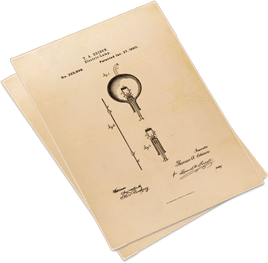U.S. patents are issued in the name of the individual or individuals who invented the new technology. Inventors may sell or otherwise assign (often under the terms of the inventors’ employment, for instance) some or all of their rights in a particular invention to another individual, a business entity, or even a government, and such an assignee may take an active role in the patent application process. Nevertheless credit for inventions is always attributable to inventors as individuals. Corporations cannot be inventors.
In general, an invention is patentable only if it is not already “in the public domain.” In the United States and Canada, once an invention has been publicly used or disclosed, the inventor has one year in which to file a patent application for that invention. For other countries, any public disclosure may render it unpatentable.
Traditionally in the United States, the contents of a patent application have been confidential and would remain so until a patent issued, unless the inventor chose to disclose the invention. The practice in most other countries is to publish the patent application 18 months after it is filed, making a public disclosure of the invention. Recent changes in U.S. law brought U.S. practice more in line with the rest of the world, mandating that U.S. patent applications filed after November 29, 2000, will be published 18 months after filing, unless the inventor declares no intention to seek patent protection outside the U.S.
A patent application contains a narrative description of the invention and itemizes the details of the invention claimed by the applicant to be novel and protectable by patent (the “claims”). In addition, the application must contain the name(s) of the inventor(s) and the title of the invention. A patent application also usually contains a drawing or drawings, and it must contain any further information necessary to describe the invention. While there are variations from country to country in particular requirements and conventions (for instance, it is usually a requirement that the application be written in the language of the country in which patent protection is sought), the form of the patent application is essentially the same for all countries.
Once filed, the claims made in the patent application are examined for novelty and usefulness in light of the history of invention within the particular technology or technologies embodied in, or related to, the claimed invention. The Patent Classification System helps to identify the historical and technological characteristics that a particular invention possesses, and so helps to locate all of the previously disclosed inventions similar to the claimed invention. Patent examiners typically have some skill in each area of technology for which they examine patent applications. In the United States, a technical degree (usually at least a Bachelor of Science) is required both for patent examiners and for the patent agents and patent attorneys who are admitted to practice in the U.S. PTO.
The patent application process, in essence, is a negotiation between the patent examiner and the inventor that usually lasts for months, and sometimes can last for years. The examiner seeks to exclude those claims that he or she considers to describe devices, processes, compositions of matter, etc., that have been disclosed in, or are obvious from, previous patents, or that became otherwise publicly known, prior to the filing of the application. This “prior art” may be a single reference describing the applicant’s invention exactly, or it may comprise several references taken together. The inventor, on the other hand, attempts to justify the creativity, inventiveness, novelty and usefulness of each and every facet of the invention claimed.
The matter of patent application filing dates and their effect on the priority of patent claims is confusing, but it is critical to the acquisition of patent rights. The matter is made confusing, in some respects, by another way in which U.S. patent law presently differs from the patent laws of other countries. Other than in the United States, patent protection generally accrues to the first inventor to claim the invention by filing the patent application in a particular country. U.S. patent law, however, currently provides that rights in an invention belong to the first to practice the invention, regardless of who may file an application first. (Nevertheless, the first inventor may still forfeit his or her rights for failure to use diligence in reducing the invention to practice.)


